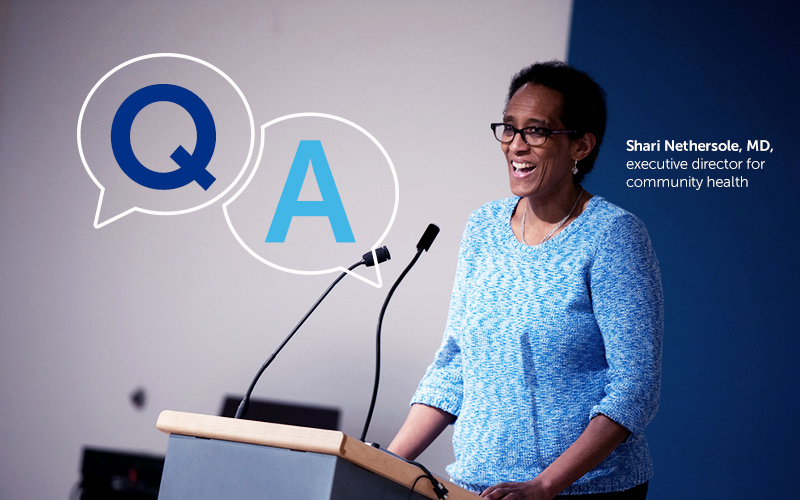The impact of COVID-19 on communities of color

Throughout the COVID-19 outbreak, it has become increasingly clear that some racial and ethnic groups have high rates of infection and death from the virus. Recent national data from the U.S. Centers for Disease Control and Prevention (CDC) reveals that Black Americans are five times more likely than white Americans to get COVID-19, and Latino Americans are four times more likely. In Boston, the numbers paint a similar picture among adults.
With growing awareness of the effect of COVID-19 on these populations, Dr. Shari Nethersole, executive director for Community Health at Boston Children’s Hospital, points out that Boston Children’s is committed to doing its part to help support families in vulnerable communities.
Here, she answers some common questions about this complex situation:
Why are some racial and ethnic groups more affected by COVID-19 than others?
Blacks and Latinos in particular have been heavily affected during the COVID-19 pandemic. This is in large part due to deep-rooted social and health inequities (disadvantages that cause them to receive less care and lower quality of care than other populations). Many social determinants of health — environmental, social, or behavioral factors that influence a person’s health status), such as occupation, education level, income level, and housing conditions — contribute to these disparities.
In addition, Black and Latino adults have higher rates of chronic diseases including diabetes, obesity, and high blood pressure, which make them more susceptible to having severe COVID-19 symptoms if they do become ill. These are just some of the contributing factors; we may not know all of them.
How does living in poverty increase the risk of getting COVID-19?
Living in a low-income household can increase a person’s risk of getting COVID-19 for several reasons. For instance, many low-income workers hold essential jobs that don’t offer the option to work from home, which increases risk of exposure. They may also live in housing with multiple family members and significant crowding, making it difficult to quarantine if someone becomes ill. Some of those family members may be older, which can make them more vulnerable. When people do get sick, they may not have adequate health insurance or resources to cover co-pays and prescriptions. In addition, many families rely on public transportation for work, so they face greater exposure. Families may also struggle to find enough masks for the whole family or access necessary cleaning supplies. All of these factors can increase their risk of COVID-19.

These neighborhoods with high COVID-19 rates also have high populations of Black and Latino residents, who are more likely to experience factors such as low income, overcrowding, and lack of access to health care, which can increase their risk of getting sick.
Are children at higher risk of getting sick?
While children of all races seem to be less likely to become seriously ill with COVID-19, a small number of children seem to be getting a related — and very serious — illness called multisystem inflammatory syndrome in children (MIS-C). The latest data from the CDC show that 31 percent of MIS-C cases have occurred in Hispanic or Latino children, and 25 percent in Black children, while cases among white children account for 19 percent. While much is still unknown about MIS-C, experts believe it occurs in children who either tested positive for COVID-19 themselves or were exposed to someone else who had it. This illustrates one more way that minority children are at increased risk for being affected by COVID-19.
What are other ways COVID-19 has led to an increase in disparities?
Parents who hold essential jobs may have missed work because they could not access childcare and may have struggled with financial resources to cover their rent and expenses. While there is a current ban on foreclosures and evictions in Boston right now, that ban is slated to expire in October and many families could end up homeless. At the Boston Children’s Hospital Primary Care Center, as well as at many of our community partners, over the past few months there has been a steep increase in food insecurity, as well as an increase in many others asking for assistance with diapers or formula. All of these factors have a big effect on children.
How is Boston Children’s addressing these challenges?
Boston Children’s has a long-standing commitment to taking care not only of children’s health, but also caring for the health of the communities in which they live. The Office of Community Health works with community partners to improve health outcomes and address health disparities in Boston. During the COVID-19 outbreak, this commitment continues and we have identified new ways to increase our support to children and families. For instance, we will be designating $500,000 in small grant funding ($5,000 to $10,000 per recipient) to individual childcare programs in communities that are predominantly Black and Latino, to support reopening of quality childcare and allow parents to return to work/school.
Through the Boston Children’s Primary Care Center, we screen patients and families for any health-related social needs we can help them address. Through our social workers and patient navigators, we are working with other organizations to provide food, money to help cover rent and utilities, gift cards for groceries, air conditioners, transportation to stores and appointments, online yoga classes, and much more. We help families access mental health services to deal with the stress they are facing, as well.
Learn more about our response to COVID-19 and access a list of community resources.
Related Posts :
-

Model enables study of age-specific responses to COVID mRNA vaccines in a dish
mRNA vaccines clearly saved lives during the COVID-19 pandemic, but several studies suggest that older people had a somewhat reduced ...
-

Making pediatric health equity research truly equitable: An EDI review process
A burgeoning number of studies are examining pediatric health equity, diversity, and inclusion (EDI). But if not done right, health ...
-

New insight into the effects of PPIs in children
Proton-pump inhibitors (PPIs) are frequently prescribed to suppress stomach acid in patients with gastroesophageal reflux disease (GERD). Prescribing rates of ...
-

Creating the next generation of mRNA vaccines
During the COVID-19 pandemic, mRNA vaccines came to the rescue, developed in record time and saving lives worldwide. Researchers in ...





